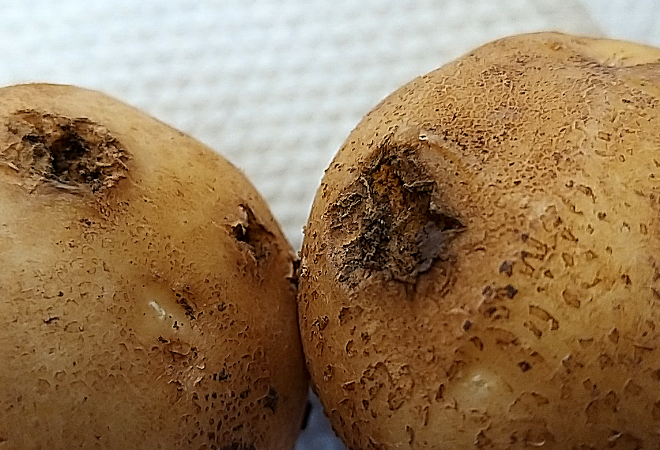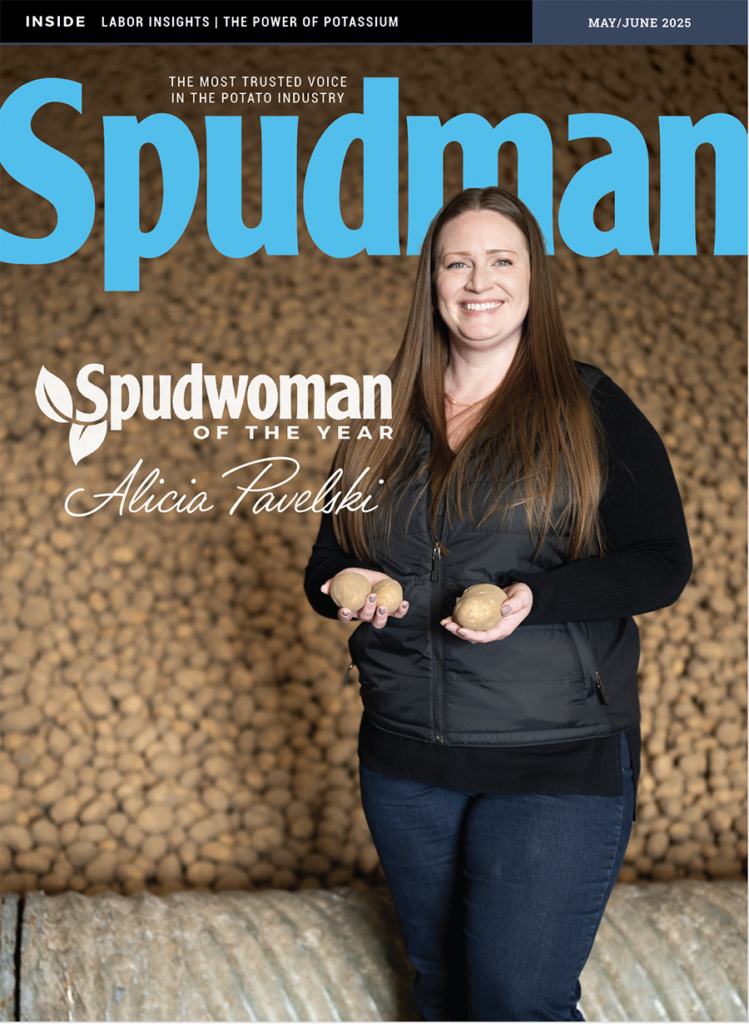
Powdery scab suppression remains elusive so far
Powdery scab, caused by Spongospora subterranea, is a worrisome disease for potato growers around the world for a variety of reasons.
- Powdery scab can stay present in soil for a long period of time. It has been known to persist anywhere from three to 10 years and even longer, on occasion.
- Spongospora can vector potato mop-top virus (PMTV), which can be even more damaging, e.g., tuber necrosis.
- Perhaps the most concerning is that there isn’t a proven effective method to control powdery scab, at least not one that is cost-effective.
“It’s pretty easy to literally overlook soilborne diseases, but I think powdery scab and PMTV are important considerations,” said James Woodhall, a plant pathologist at the University of Idaho’s Parma Research and Extension Center. “Know your fields and know the potential inoculum present in them and if you are unsure, a soil test could be useful — these should give you a value as to the amount of powdery scab and/or PMTV present in soil.”
Powdery scab consists of lesions on the surface of tubers that contain powder, hence the name. Tubers with powdery scab are still edible, but are much less desirable in the fresh and processing markets. In extreme cases, lesions can eat away at the tubers.
In addition, powdery scab causes galls on stolons or roots. Powdery scab alone does not typically cause yield reduction, although it has in studies in Australia and New Zealand, said Leah Tsor of the Agricultural Research Organization in Israel. Tsor recently hosted a World Potato Congress webinar on powdery scab.
“The galls on the root can cause them to malfunction and lead to yield reduction,” said Tsor, who noted the results from Australia. “There has been no reported yield reduction in (the state of) Washington. If other soilborne pathogens, such as rhizoctonia, or nematodes are present, then it might lead to reduction.”
Disease development most often occurs in certain conditions, Tsor said. When a host is present, obviously, but usually only when there is high moisture and the soil is cool — between 48 and 64°F. Infection of tubers usually only occurs during initiation, but root infection can occur at any point during the season.
PS survives soil, plant residues, animal manure, volunteer potato plants, machinery and can be spread by water runoff. Tsor said recent tests in Israel showed it can spread by wind up to 750 yards.
Suppression
Experiments have taken place with a variety of biologicals and chemicals in recent years and have shown some promise, but are not ready to implement commercially as of yet.

“Fluazinam has been shown to provide 20-40% suppression, but this is not great control for the cost of the treatment,” said Jeff Miller of Miller Research in Rupert, Idaho.
Tsor said trials in Japan in 2017 showed the biological Aspergillus versicolor, a fungus, reduced powdery scab between 54 and 70%.
“There also are reports on Trichoderma and Bacillus as biocontrol agents, however, these treatments are not consistent,” she added. “As far as I know, there is no commercial material that is targeted to control powdery scab.”
Metam sodium and chloropicrin have been used in some studies, Tsor said, but with mixed results. “But more testing is probably needed,” she added.
Because high moisture is usually present for PS to infect, Miller said irrigation practices can play a factor, but added that irrigating to plants’ needs and not irrigating to the point of creating PS-conductive conditions is a fine line.
“Some research has shown that proper irrigation management can reduce disease severity, but this may only suppress the disease,” he said. “Reducing soil moisture at the time of tuber initiation has been shown to suppress the disease, but this can exacerbate common scab. Irrigating to plant needs can still create conditions favorable for disease development.”
Because powdery scab and common scab have very similar symptoms, researchers say testing is often necessary to know for sure if PS is present.
Avoidance
Like with any pathogen or pest, minimizing risk is the best preemptive strategy. A few best practices:
- Don’t plant where PS has been present. Researchers encourage soil testing as opposed to just trying to go by memory alone.
- Longer rotations are encouraged, but with the length of time powdery scab can be present in soil, even a four- or five-year cycle still poses risk.
- Use PS-free compost/manure. Cows that have been fed powdery scab-infected crops can pass it on through manure.
- Sanitize equipment often, including tractors, planting, harvesting, sorters, graders and storage.
- Utilize optimal fertilization and irrigation practices. Try to avoid soil compaction and water logging.
- Use resistant varieties (more information below).
- Plant disease-free certified seed. (There is currently not a seed treatment for powdery scab, Tsor said.)
Rotational crops, cover crops and weeds also can be hosts for powdery scab. In inoculation studies conducted by Tsor, 14 of 77 crops showed susceptibility, with tomato and radish being on the high end. Some others included a variety of wheats, barley and bur clover. Carrot and two kinds of oats were at the low end.
Fifty-two plants across eight species of weeds also were tested, with 16 showing susceptibility. Solanum nigrum (black nightshade) was far and away the most susceptible.
Resistant varieties
Kiwamu Tanaka, a pathologist at Washington State University, said russets’ skin tends to hold up better against powdery scab during the tuber phase, although russets still can be susceptible during the root phase.
His WSU colleagues, Dennis Johnson and Thomas Cummings, did extensive studies on two russets — Mesa and Umatilla — and Shepody, an early-season fryer. The tests showed Mesa to be very resistant, Umatilla moderately resistant and Shepody as the most susceptible in terms of root gall formation.
Field studies conducted in Minnesota in 2016 by North Dakota State University showed several varieties to be very resistant during both the tuber and root phases, including: Alturas, Atlantic, Bannock, Dakota Jewel, Dakota Russet, Dakota Trailblazer, Dark Red Norland, Karu, Ranger, Norkotah and Yukon Gold.
Ivory Crisp, Kennebec and Shepody showed the most susceptibility.
Path to resistance
Tanaka has done extensive work on identifying elicitor peptides (or defense inducers) in plants for the purpose of testing them against powdery scab. These elicitors, if testing shows any to be successful in combating the disease, can be used for breeding new varieties that are resistant, as well as possible development of novel fungicides.
“We will also test the effect of the identified elicitor against other pathogens that cause Pythium leak, pink rot, Fusarium dry rot, silver scurf and soft rot,” Tanaka said. The project is ongoing, but approximately 100 peptides have been identified as possible immunostimulant candidates against powdery scab. The goal of this project is to deliver the immunostimulants (elicitor peptides) using engineered bacillus biocontrol agents, which could be deployed on farmer-preferred cultivars in the future.
Until researchers and crop protection providers can develop better suppression tools, powdery scab control will have to be mostly from preventative practices. Although PS isn’t a new disease, its connection to vectoring the emerging mop-top virus does make it troublesome.
“There is no single best method growers have to use a combination of approaches to keep on top of it if it is present in their fields, particularly if they only have short rotations,” Woodhall said.
Top photo: Washington State University














